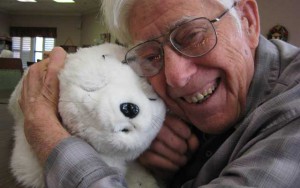Paro the Robotic Seal – Is the Illusion of Companionship Good Enough?
 Paro and a new friend (image via parorobots.com)
Paro and a new friend (image via parorobots.com) Technology is fascinating. Throughout history it has changed the way we interact with our work, our environment, and even with each other. Social technology connects us through the cell phones in our pockets, the Internet at home and in the office, and even through robotics in our care facilities. But rather than celebrate each new release, does it pay to consider the ramifications of social technology?
Paro is a therapy robot in the form of a baby harp seal, used predominantly by senior living facilities as an alternative to therapy involving nonhuman animals. The residents are so touched by Paro that they sing to it, they talk to it, and they tell it all about their lives. Through its different sensors, Paro responds to touch, light, temperature, and audio.
Recently, Front Porch, a conglomerate that provides retirement communities and senior living facilities in California, released the results of a six-month study involving Paro’s therapeutic effects on residents within their memory care facilities. The results were overwhelmingly positive. They found that Paro increased social behavior in 97 percent of isolated residents, calmed 60 percent of residents who typically display anxious behaviors, and helped 79 percent of lethargic residents remain more alert. Ultimately, they concluded that Paro positively improved mood, socialization, and appetite of those who participated.
Paro isn’t just a robot to provide comfort to those who are lonely. Paro is used in situations that are particularly difficult for nursing home staffers to address. “Front Porch is exploring creative solutions to address needs for which we currently don’t have an easy solution,” says Kari Olson, chief innovation and technology officer of Front Porch. Olson went on to identify ways Paro could help in difficult situations: “agitation in the middle of the night, sundowning, engaging withdrawn or isolated residents.” It’s also thought that Paro can reduce the use of psychotropic medications for those with dementia. With the promise of a greater quality of life for its patients, why wouldn’t a care facility use a robot like the cuddly white seal?

Paro (image via parorobots.com)
However, not all researchers see Paro as overwhelmingly positive. Sherry Turkle, a professor in the program in science, technology, and society at MIT, told NPR that her first experience with Paro made her feel “profoundly depressed.” Turkle described what she observed the day she and her graduate students went to see Paro interact with a woman in a nursing home: “What was extraordinary, to me, is that although she was surrounded by people who were in a position to understand her story, we were kind of applauding and stepping back, and cheering on her connection to a machine that understood nothing.” For Turkle, Paro represents humanity’s willingness to redefine our connections and how we care for each other. Even with her concern, she sees Paro as an invaluable opportunity to affirm human values and address the direction of our technology and what needs we’re serving.
Perhaps Paro represents a larger picture: “I think we’re setting ourselves up for trouble—trouble, certainly, in how we relate to each other; but also trouble in how we relate to ourselves, in our capacity for self-reflection,” Turkle notes. And her point is definitely worth considering. Social technologies often provide an illusion, not the real thing. For scientists like Turkle, the real thing matters. “What is it to suggest chatting with an entity that has no idea what you’re saying?” she asks. “Why would we want to do that to ourselves, to construct false relationships?”
Turkle certainly raises important questions. Although Paro’s therapeutic value is crucial for difficult-to-reach patients, its technology isn’t unlike simulation game phone apps or virtual pets—social technologies that are used by millions daily. These technologies create an illusion of agreeable social interaction. Constant exposure to this form of technology may change how we define our relationships and care for each other. So the question is: does the illusion matter? Perhaps it’s time to call for a more conscientious conversation to consider the purpose of our social technology and what its progress means for the future of human connection.
